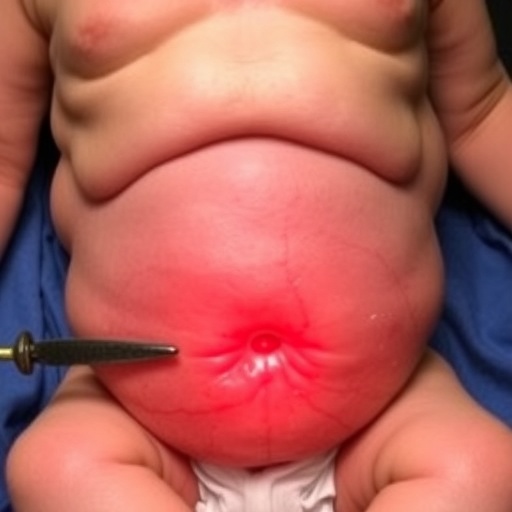In a striking case that sheds light on a rarely discussed but significant medical condition, a team of researchers spearheaded by Plessi, Spampinato, and Caponcelli has provided an in-depth investigation into idiopathic scrotal hematoma in newborns. This condition, characterized by the accumulation of blood within the scrotum without an evident cause, poses unique challenges in both diagnosis and treatment. Their recent publication in Pediatric Radiology serves not only to document a fascinating case but also to weave together existing literature for a comprehensive review on the topic.
The emergence of idiopathic scrotal hematoma, especially in neonates, is an area that garners less attention compared to other neonatal conditions. This is partly due to the infrequency of occurrences and complications related to this condition. However, neonatal practitioners and pediatric radiologists must remain vigilant and knowledgeable about the signs and symptoms associated with this complication. The lack of definitive studies historically limits our understanding, thus making studies like this one particularly noteworthy.
Current clinical practices often involve differential diagnoses that encompass a broad spectrum of conditions that could lead to similar presentations. For instance, vascular malformations, trauma during birth, or even underlying coagulopathies could manifest signs similar to those observed in scrotal hematoma. This study enhances the dialogue surrounding such conditions, giving practitioners tools for more effective clinical assessments.
The innovative imaging techniques employed in this study further amplify its significance. The authors utilized advanced ultrasound imaging methods to identify the presence of a hematoma, demonstrating the importance of non-invasive approaches in pediatric care. Ultrasound remains the first-line imaging modality for evaluating scrotal conditions in newborns due to its safety, accessibility, and ability to provide real-time feedback. High-resolution imaging techniques can reveal the size and extent of the hematoma while allowing clinicians to rule out other potential causes.
In this particular case report, the newborn presented with a scrotal swelling that raised immediate concerns among the medical team. Their diligence led to an expedited workup that confirmed the diagnosis of idiopathic scrotal hematoma. Remarkably, the absence of any underlying trauma or systemic disease pointed towards idiopathic origins, inciting further inquiry into the mechanisms behind such hematomas in this young population.
The literature review encapsulated in this study serves as both a historical and contemporary examination of idiopathic scrotal hematomas. It juxtaposes findings from previous case reports and cohort studies with the current case, highlighting trends and themes that persist in neonatal surgery. A particular focus was placed on the implications of timing in diagnosis and management. Early recognition and intervention seem vital to alleviate any potential complications that could otherwise arise from delayed treatment.
Given that the majority of idiopathic scrotal hematomas provide favorable outcomes with conservative management, the report also emphasizes the importance of tailored care plans. By promoting a strategy that often employs observation over surgical intervention, this research underscores a paradigm shift in handling such complexities. However, the authors do caution against complacency, reminding practitioners to remain vigilant and prepared for the rare but possible eventuality of surgical requirements.
The addition of detailed case descriptions within the literature highlights the variability of clinical presentations associated with idiopathic scrotal hematomas. Through visual and clinical documentation, the authors aim to enrich the existing body of knowledge, ensuring that this condition receives the attention it deserves within the pediatric community. Each case has unique elements that contribute to a clearer understanding of this rare occurrence, which may guide future research directions as well.
Notably, the emotional and psychological impacts on families dealing with an idiopathic scrotal hematoma should not be overlooked. Educating parents about the condition, its implications, and the prognosis can help alleviate anxieties. In this regard, the article advocates for open communication between clinicians and families, fostering a supportive environment that underscores trust and reassurance during potentially distressing times.
As the field of pediatric medicine continues to evolve, it is research like that of Plessi et al. that propels it forward. This study not only provides critical insights into a seldom-discussed condition but also lays the groundwork for further exploration. The identification of idiopathic scrotal hematoma as a clinical entity deserves ongoing attention, investment, and scholarly inquiry.
In conclusion, the case report and accompanying literature review present a significant contribution to pediatric radiology and neonatal medicine. By providing a comprehensive overview of idiopathic scrotal hematoma, the authors have ignited a broader conversation about addressing this rare condition effectively. Their timely research paves the way for future studies to refine clinical protocols and optimize patient care in newborns facing similar challenges.
The implications of this study extend beyond the immediate medical community; it challenges clinicians to remain educated about uncommon presentations and encourages ongoing discussions about best practices in the management of atypical neonatal conditions. As more practitioners engage with these findings, one can hope that the visibility of idiopathic scrotal hematoma will continue to grow, ultimately leading to improved patient outcomes.
Strong collaboration across various medical disciplines may also yield novel insights and innovative management strategies. Cross-pollination of ideas can accelerate breakthroughs, ensuring that future generations of healthcare professionals are better equipped to handle a range of conditions, including those that are rare yet impactful, such as idiopathic scrotal hematoma in newborns.
As we move forward into an era defined by rapid advancements in medical technology and research, the findings of Plessi and colleagues stand as a reminder of the importance of vigilance, compassion, and lifelong learning that is essential in the ever-evolving field of pediatric healthcare.
Subject of Research: Idiopathic scrotal hematoma in newborns
Article Title: Idiopathic scrotal hematoma in newborns: a case report and literature review.
Article References:
Plessi, C., Spampinato, G., Caponcelli, E. et al. Idiopathic scrotal hematoma in newborns: a case report and literature review.
Pediatr Radiol (2025). https://doi.org/10.1007/s00247-025-06357-5
Image Credits: AI Generated
DOI: https://doi.org/10.1007/s00247-025-06357-5
Keywords: Idiopathic scrotal hematoma, newborns, pediatric radiology, ultrasound imaging, case report.




